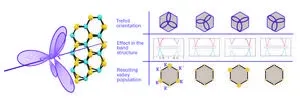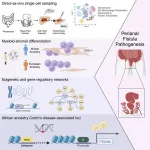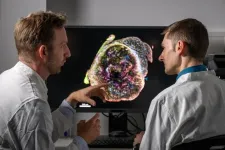Crossing a busy street safely typically is a result of a social exchange. Pedestrians look for cues—a wave, a head nod, a winking flash of the headlights, and, of course, a full vehicle stop—to know it’s safe to cross.
But those clues could be absent or different with self-driving vehicles. How will children and adults know when it’s safe to cross the road?
In a new study, University of Iowa researchers investigated how pre-teenage children determined when it was safe to cross a residential street with oncoming self-driving cars. The researchers found children made the safest choices when self-driving cars indicated via a green light on top of the vehicle that it was safe to cross when the vehicle arrived at the intersection, then stopped. When self-driving cars turned on the green light farther away from the crossing point—and even when they slowed down—children engaged in riskier intersection crossings, the researchers learned.
“Children exhibited much safer behavior when the light turned green later,” says Jodie Plumert, professor in the Department of Psychological and Brain Sciences and the study’s senior author. “They seemed to treat it like a walk light and waited for that light to come on before starting to cross. Our recommendation, then, for autonomous vehicle design is that their signals should turn on when the car comes to a stop, but not before.”
The difference in the timing of the green light signal from the self-driving car is important: Children are inclined to use the light as the vehicle’s clearance to go ahead and cross, trusting that it will stop as it gets closer to the intersection. But as Plumert and co-author Elizabeth O’Neal point out, that could invite peril.
“This could be dangerous if the car for some reason does not stop, though pedestrians will have the benefit of getting across the road sooner,” says Plumert, who is the Russell B. and Florence D. Day Chair in Liberal Arts and Sciences.
“So, even though it may be tempting to make the traffic flow more efficient by having these signals come on early, it’s probably pretty dangerous for kids in particular,” adds O’Neal, assistant professor in the Department of Community and Behavioral Health and the study’s corresponding author.
Some may see self-driving vehicles as a futuristic technology, but they are operating right now in American cities. The Insurance Institute for Highway Safety projects there will be 3.5 million vehicles with self-driving functionality on U.S. roads by next year, and 4.5 million by 2030. This year, an autonomous-vehicle taxi service, called Waymo One, will operate in four cities, including new routes in Los Angeles and Austin, Texas.
This comes as pedestrian deaths from motor vehicles remains a serious concern. According to the Governors Highway Safety Association, more than 7,500 pedestrians were killed by drivers in 2022, a 40-year high.
“The fact is drivers don’t always come to a complete stop, even with stop signs,” notes Plumert, who has studied vehicle-pedestrian interactions since 2012. “People are running stop signs all the time. Sometimes drivers don’t see people. Sometimes they’re just spacing out.”
The researchers aimed to understand how children respond to two different cues from self-driving cars when deciding when to cross a road: gradual versus a sudden (later) slowing; and the distance from the crossing point when a green light signal atop the vehicle was activated. The researchers placed nearly 100 children ages 8 to 12 in a realistic simulated environment and asked them to cross one lane of a road with oncoming driverless vehicles. The crossings took place in an immersive, 3D interactive space at the Hank Virtual Environments Lab on the UI campus.
Researchers observed and recorded the children’s crossing actions and spoke with them after the sessions to learn more about how they responded to the green light signaling and the timing of the vehicle slowing.
One major difference in crossing behavior: When the car’s green light turned on farther away from the crossing point, child participants entered the intersection on average 1.5 seconds sooner than the kids whose scenario included the light coming on later and the vehicle had stopped at the crossing point.
“That time difference is actually quite significant,” Plumert notes. “A green light signal that flashes early is potentially dangerous because kids and even adults will use it as a cue to begin crossing, trusting that the car is going to come to a stop.”
The results build on findings published in 2017 by Plumert and O’Neal that children up to their early teenage years had difficulty consistently crossing a street safely in a virtual environment, with accident rates as high as 8% with 6-year-olds.
That danger underscores the need for clear, easy-to-understand signaling to children from self-driving vehicles, the researchers say. Researchers are testing various communicative signals, including flashing lights, projecting eyes on the windshield, splashing racer stripes on the edge of the windshield, and written words (like walk/don’t walk).
“All have some utility, but children are a special case,” says O’Neal, who earned a doctorate in psychology at Iowa in 2018 and had been working as a postdoctoral researcher in Plumert’s lab before joining the faculty in the College of Public Health. “They may not always be able to incorporate a flashing light or a racing light to indicate that it’s slowing or that it’s going to yield to you.”
Children naturally understood signaling using a green light and a red light, the researchers found. But timing is critical, they learned.
“We think vehicle manufacturers should not consider the idea of turning the light on early or having the signal present early,” Plumert says, “because people will definitely use that, and they’ll get out there in front of the approaching vehicle. People hate to wait.”
The study is titled, "Deciding when to cross in front of an autonomous vehicle: How child and adult pedestrians respond to eHMI timing and vehicle kinematics." It published online on April 24 in the journal Accident Analysis and Prevention.
Lakshmi Subramanian, who earned a doctorate from Iowa and now is at Kean University in New Jersey, shares first authorship on the study. Joseph Kearney, professor emeritus in the Department of Computer Science, is a senior author. Contributing authors include Nam-Yoon Kim and Megan Noonan in the Department of Psychological and Brain Sciences.
The U.S. National Science Foundation and the U.S. Department of Transportation funded the research.
END






